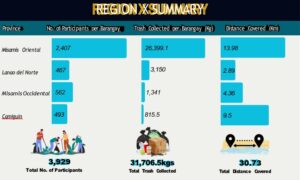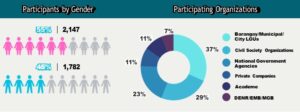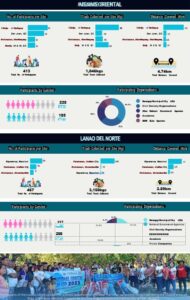I. Preparatory Activities
a. Conduct of Meetings
In preparation for the upcoming activity and to level-off on the activities that needs to be done, the DENR-X Regional Office thru the CRFMS, conducted a virtual meeting via Google Meet on September 7, 2023. It was participated by DENR-X key personnel/representatives from the various divisions of the Regional Office, EMB-X, MGB-X, other interested National Government Agencies, LGUs, Academe, NGOs, CSOs, Private Companies, and Focal Persons/Representatives from the 12 coastal barangays. The meeting aimed to unify the different sectors for the success of the event. The expected participants, protocols for the clean-up activity, and filling out of trash data cards, and ways of reporting were discussed. A follow-up meeting among the trash coordinators was also conducted on September 12, 2023 for finalization of necessary matters for a smooth clean-up activity.
b. Communication, Education and Public Awareness
DENR-X field offices have also conducted several activities prior to the clean-up activity and in line with the celebration of the International Coastal Clean-up, such as the hanging of streamers and tarpapel in the office premises and other conspicuous places, the distribution of IEC materials to the LGUs, coastal communities, and residents, coordination with LGUs for the conduct of the same activity, and lectures on the significance of the coastal ecosystem and proper collection of trash. These activities play a significant role in the success of the event by informing and increasing public awareness and encouraging everyone’s participation.
II. CY 2023 ICC REGIONAL SUMMARY
Coastal clean-up activities were conducted within the coastal areas of the four coastal provinces across Region X on September 14-16, 2023 spearheaded by various field offices of the DENR-X. Aside from DENR-led clean-up drive, the MLGU of Mahinog, Camiguin also led the same activity in its coastal barangays on September 23, 2023 through the encouragement of PENRO Camiguin.
The graph above shows the summary of the region-wide clean up activities as to the total number of participants, total trash collected, and total distance covered. As seen in the graph, the province of Misamis Oriental topped among the four provinces with 2,407 participants or equivalent to 61% with 26,399.1 kilograms or 83% of the total trash collected within the 13.98km cleaned-up coastal areas of the province.
From these figures, it is evident that the coastal areas within the province of Misamis Oriental has the highest volume of trash that might end up in the ocean if not regularly collected. One factor that contribute to this figure may be linked to the number of participants who joined the clean-up activity. Also, the cleaned-up site is located within the heart of Cagayan de Oro City being the regional capital of Region X and top 7th of the highly urbanized cities across the country (source: https://cmci.dti.gov.ph/rankings-data.php?unit=Highly%20Urbanized%20Cities).
Other factors that contributed to the volume of waste generated may also include the following:
- size and density of population that is also associated to the extensive socio-economic activities
- lack of or minimal proper collection of waste from the source
- eased off or lack of barangay ordinances to penalize improper waste disposal
- inadequate waste management system such as well designed collection system, disposal sites, or recycling facilities
- lack of or poor waste management practices within upstream barangays
The above ratio also shows that among the four provinces, each participant in the Misamis Oriental clean-up drive has collected the highest number of trash, with an average of 11 kg per person. This figure supports the aforementioned discussion that there is more trash that ends up along the coastal areas of the province of Misamis Oriental compared to the other coastal provinces of the region.
The aforestated factors can be a great tool for local policymakers in planning strategies to prevent or at least minimize improper waste disposal and craft, improve, revisit, or strengthen existing local ordinances.
The activity was dominated by female participants, accounting for 54% of the total participants that joined the clean-up drive within Region X. Women plays a vital role in the cleanliness not just in their homes but also in their community thus, their active participation in this activity. Despite the fact that just 42% of participants are men, their participation is still very important because men are stronger and play different roles in trash management than women.
The participation of the Barangay/Municipal/City LGUs constitute the highest number, with 37% of the overall number of participating groups and organizations. The launching and implementation of the Barangay at Kalinisan Day (BarKaDa) through DILG Memorandum Circular 2023-133 contribute to the significant number of participants from the BLGUs/MLGUs/CLGUs. BarKaDa is a nationwide community-based clean-up drive program, geared to maintain and provide a healthy and safe environment and prevent the spread of diseases through proper solid waste management. Barangays are required to conduct coastal clean-up, dredge congested waterways, cut heavy shrubs or branches, and demolish mosquito breeding sites in coastal areas, rivers, creeks, public parks, highways, and other public spaces within their jurisdictions during BarKaDa.
Their active participation and involvement are a great contribution to this kind of activity, and it is a good option to invite and encourage them again in the future for similar activities. Likewise, the participation of other Civil Society Organizations (CSOs) and National Government Agencies (NGAs) are also a significant contribution, being the active group of individuals and public servants that are also taking initiatives and front-liners in implementing the policies of the government.
III. CY 2023 ICC DATA BY KEY CITY/PROVINCE
IV. CONCLUSION AND RECOMMENDATIONS
The annual celebration of the International Coastal Clean-up is a significant event to pursue our continuous efforts in attaining a trash-free oceans or at least minimizing the waste deposited at the sea. This year, we advocated to clean the seas not only for its aesthetic value but also for the organisms that thrive on it which can be directly affected by foreign materials or pollutants. Being the home of the largest ecosystem on Earth, many organisms depend from our healthy oceans including us humans. Thus, it is very essential to keep our oceans free from trash and other form of marine pollution for it to provide us and our future generations the healthy food we deserve.
The data gathered from the event generates the following recommendations, to wit:
- Close coordination between tributary barangays to map out and plan strategies on how to minimize waste disposal into the rivers that might eventually end up in seas;
- Revisit existing local ordinances and evaluate its effectivity; Formulate and issue supplemental ordinances if necessary; Strengthen the implementation of RA 9003 at the Barangay level;
- Continue the conduct of IEC activities not just in the coastal barangays but including the upland tributary barangays; and
- Each barangay should support and continue the implementation of the Barangay at Kalinisan Day (BarKaDa) program and encourage the community’s participation to attain its objectives.













